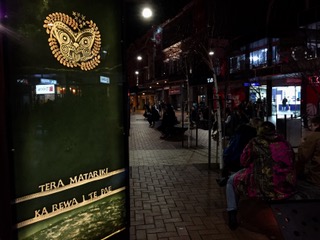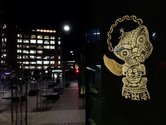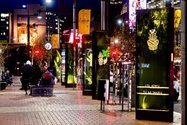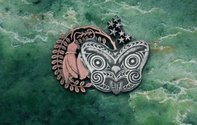Mary-Jane Duffy – 20 September, 2018
What sets Matthew's work apart from a European tradition are his compositions. He brings together components from different coins to make new images—a tui from an old two cent piece sits on the head of the tiki face from a ten cent piece. And these compositions open up the big story of our colonial history, but are also a metaphor for the artist's own whakapapa and for the coming together of cultures, the experience of which informs our recent past.
Wellington
Matthew McIntyre Wilson
Whetu Whitu
1 June - 20 August 2018
Matthew McIntyre Wilson is known for his inventive use of metals. He’s woven fine mats from copper, korowai from copper and electrical wire, and made brooches and pendants from coins. Whetu Whitu, his recent installation in the Light Boxes in Courtenay Place, Wellington, scaled up his coin works into life-sized images to celebrate Matariki and ten years of making these delicate intricately detailed works.
Jewellery from coins has a long history in Europe and America. Coin silver is a composite of copper alloy and nickel, and though the silver is an allusion, it’s an accessible material for jewellery making. My Google search brings up coin necklaces, pendants, and earrings with backgrounds cut away to emphasis an image inside the round frame of the coin.
Matthew learned how to cut coins when he studied jewellery at Whitireia with Peter Deckers—whose mother had taught him how to cut coins. What sets Matthew’s work apart from this European tradition are his compositions. He brings together components from different coins to make new images—a tui from an old two cent piece sits on the head of the tiki face from a ten cent piece. And these compositions open up the big story of our colonial history, but are also a metaphor for the artist’s own whakapapa and for the coming together of cultures, the experience of which informs our recent past.
Matthew selected particular symbols from the humble coin to make up his narrative. All of the coins are from New Zealand and England except for a few from the Cook Islands where some of his ancestors rested before coming on to Aotearoa. In a strip across the bottom of each image were the lines of a karakia about Matatiriki by Dr Huirangi Waikereperu. All of the letters that made up the words and the horizontal lines beneath them were sourced from coins. And the images above matched the words and imagery of the karakia which speaks eloquently of the blossoming of the dawn, and the birdsong of the season.
A tiki face is central to each work. Sometimes the face is attached to the body of a whale, sometimes a kiwi. At other times, it is surrounded by ferns or crowned with symbols of ancestry like the thistle, the shamrock or the crossed patu, or topped with a ship in full sail. These are the symbols of Matthew’s whakapapa, the mixture of Scottish, Irish, English, Maori and Cook Island heritage that make up many of us to greater or lesser degrees.
Only one work varies from this format. This work is a series of hei tiki chained together in the manner of a fob chain. It references the Parihaka prisoners who were taken away in chains when they were arrested for peaceably protesting the occupation and theft of their land. Some were taken to Nelson where they were forced to manufacture chains. Matthew remembers them in this poignant line of chained faces.
I’ve known Matthew’s work for many years, but I’ve never considered its extreme detail. Like the ubiquitous coin, I’ve taken it for granted. But Whetu Whitu provided the chance to really look at the works up close. They’ve been photographed against pieces of pounamu and then scaled to fit the light box requirements. The result—partly thanks to Matthew’s partner Natalie with whom he collaborated on this project—is something new. Matthew’s works float over the pounamu backgrounds. The lush veiny greenness of the pounamu shapeshifts in each image from the night sky, to water, stars, the bush, Papatuanuku and Ranginui. Their presence near the corner adjacent to the historic Te Aro Pa site brought a sense of living, breathing and growing history coursing along the street towards you-and a stillness in the jingle of city.
Mary-Jane Duffy










 Two Rooms presents a program of residencies and projects
Two Rooms presents a program of residencies and projects Advertising in this column
Advertising in this column



This Discussion has 0 comments.
Comment
Participate
Register to Participate.
Sign in
Sign in to an existing account.